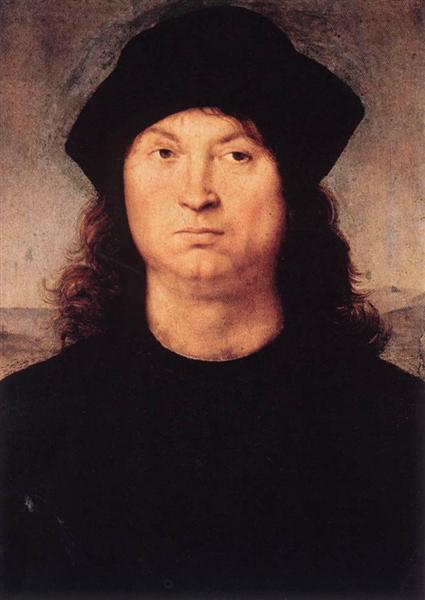Tanım
The painting "Portrait of a Man" from 1503, attributed to Raphael, is a work that encapsulates not only the artist's technical virtuosity, but also the spirit of the Italian Renaissance. This portrait is considered one of the young Raphael's earliest works and reflects his mastery in the use of color, light, and form. Through his precise handling of oil, Raphael manages to bring to life a face that evokes an intense personality, who, despite being an unknown in history, radiates dignity and resolve.
In the composition, the man is presented in an almost half-length format. His posture is upright and his gaze directly towards the viewer establishes an immediate connection, an essential characteristic of Renaissance portraiture that seeks not only to represent physical appearance, but also to capture the essence of the subject. The way in which shadows and lights shape his face reveals Raphael's ability to create volume and three-dimensionality. The subtle use of light highlights the features, accentuating the bone structure of the face and suggesting a contemplative character.
Colour plays a crucial role in this work; the palette is rich but restrained, with dark tones predominating, which lend an air of solemnity and seriousness. The choice of the dark background intensifies the figure of the man, who is dressed in a brown tunic, which can also be interpreted as a symbol of modesty. This contrast between the background and the subject allows the attention to be completely focused on his face, ensuring that the viewer's eyes cannot help but be drawn to the expression on his face, which seems to carry a personal story.
An interesting aspect that can be explored is the cultural and artistic environment in which Raphael developed. The young artist worked in a period when portraiture was beginning to flourish as an independent genre, following in the footsteps of masters such as Leonardo da Vinci and Botticelli. The influence of these masters can be seen in the attention to detail, the naturalness of expression and the meticulousness in the representation of textures.
Although the subject of "Portrait of a Man" remains unidentified, he is often associated with the condition of the Renaissance man, an individual who reflects the humanism of the age in both his appearance and character. This work fits within a broader context where portraits were not only a form of personal representation, but also a means of capturing the social status and aspirations of the individual.
In the history of art, Portrait of a Man offers a window into the beginnings of a career that would become synonymous with artistic innovation and classical beauty. While not one of Raphael's best-known works, its contribution to the development of portraiture in Renaissance painting is undeniable. The composition, use of color, and deep sense of humanity present in this work not only highlight the talent of a young Raphael, but continue to fascinate and move generations of viewers, who seek in every glance to discover the secrets of a past that, although distant, feels so close through the expressiveness of art.
KUADROS ©, a famous painting on your wall.
Hand-made oil painting reproductions, with the quality of professional artists and the distinctive seal of KUADROS ©.
Painting reproduction service with satisfaction guarantee. If you are not completely satisfied with the replica of your painting, we will refund 100% of your money.

